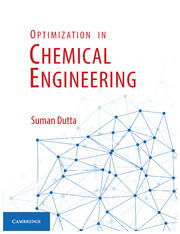Book contents
- Frontmatter
- Dedication
- Contents
- List of Figures
- List of Tables
- Preface
- 1 A Brief Discussion on Optimization
- 2 Formulation of Optimization Problems in Chemical and Biochemical Engineering
- 3 Single Variable Unconstrained Optimization Methods
- 4 Trust-Region Methods
- 5 Optimization of Unconstrained Multivariable Functions
- 6 Multivariable Optimization with Constraints
- 7 Optimization of Staged and Discrete Processes
- 8 Some Advanced Topics on Optimization
- 9 Nontraditional Optimization
- 10 Optimization of Various Chemical and Biochemical Processes
- 11 Statistical Optimization
- 12 Software Tools for Optimization Processes
- Multiple Choice Questions – 1
- Multiple Choice Questions – 2
- Multiple Choice Questions – 3
- Index
- References
9 - Nontraditional Optimization
Published online by Cambridge University Press: 05 February 2016
- Frontmatter
- Dedication
- Contents
- List of Figures
- List of Tables
- Preface
- 1 A Brief Discussion on Optimization
- 2 Formulation of Optimization Problems in Chemical and Biochemical Engineering
- 3 Single Variable Unconstrained Optimization Methods
- 4 Trust-Region Methods
- 5 Optimization of Unconstrained Multivariable Functions
- 6 Multivariable Optimization with Constraints
- 7 Optimization of Staged and Discrete Processes
- 8 Some Advanced Topics on Optimization
- 9 Nontraditional Optimization
- 10 Optimization of Various Chemical and Biochemical Processes
- 11 Statistical Optimization
- 12 Software Tools for Optimization Processes
- Multiple Choice Questions – 1
- Multiple Choice Questions – 2
- Multiple Choice Questions – 3
- Index
- References
Summary
Traditional methods have a tendency to be stuck in the local optimum point; mostly, they find the local or relative optimum point. Nontraditional methods are able to find the global optimization. These optimization algorithms are very useful to handle complicated problems in chemical engineering. In this chapter, we will discuss four methods namely Genetic Algorithm (GA), Particle Swarm Optimization (PWO), Simulated Annealing (SA), and Differential Evolution (DE) that are able to find the global optimizer. These stochastic algorithms are susceptible to premature termination. “Premature optimization is the root of all evil.” – Donald Ervin Knuth (Art of Computer Programming, Volume 1: Fundamental Algorithms). Therefore, we should be very careful about the termination criteria of these stochastic optimization algorithms; otherwise, we will get wrong information from the optimization study.
Genetic Algorithm
Many useful optimum design problems in chemical engineering are described by mixed discrete– continuous variables, discontinuous and non-convex design spaces. When the traditional nonlinear programming methods are applied for these problems, they will be ineffective and computationally expensive. Mostly, they find a local (relative) optimum point that is nearby to the starting point. Genetic algorithms (GAs) are suitable for solving of this kind of problems, and in most instances, they are able to locate the global optimum solution with high accuracy. GAs are stochastic techniques whose search procedures are modeled similar to the natural evolution. Philosophically, Genetic algorithms work based on the theory of Darwin “Survival of the fittest” in which the fittest species will persist and reproduce while the less fortunate tend to disappear. To preserve the critical information, GAs encode the optimization problem to a chromosome-like simple data structure and employ recombination operators to these structures.
The GA was first proposed by Holland in 1975 [Holland, (1975)]. This approach works based on the similarity of improving a population of solutions by transforming their gene pool. Two types of genetic modification, crossover, and mutation are utilized and the elements of the optimization vector, X, are expressed as binary strings. Crossover operation (Figs 9.1–9.2) deals with random swapping of vector elements (among parents that have highest objective function value or other ranking populations) or any linear combination of two parents. Mutation operation (Fig. 9.3) involved with the incorporation of a random variable to an element of the vector.
Information
- Type
- Chapter
- Information
- Optimization in Chemical Engineering , pp. 222 - 257Publisher: Cambridge University PressPrint publication year: 2016
